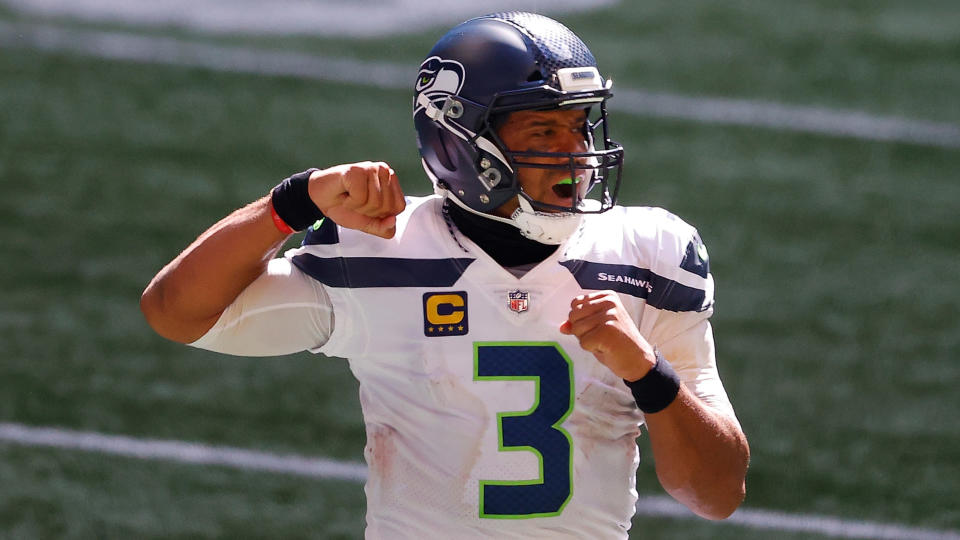Seahawks may have unlocked full potential by giving Russell Wilson the keys
If there is a defining flaw of the Pete Carroll-era Seahawks, it’s that despite their immense talent, they often get in their own way. After finally amending their run-heavy scheme to allow Russell Wilson to operate at the height of his abilities, the Seahawks are done with a stubborn commitment to their ideals of the past and have now entered their second Super Bowl contention window, with Carroll, Wilson, and All-Pro linebacker Bobby Wagner as the transitory pieces between both periods.
Wilson was magnificent in Sunday’s opener against the Atlanta Falcons, going 31-of-35 for 322 yards, four touchdowns and no interceptions as the Seahawks rolled to a 38-25 victory. It’s not that Wilson’s hyper-efficiency is particularly novel, it’s that the Seahawks allowed him to drop back at will without automatically deferring to the run game on first and second downs.
Seattle, who ran the ball just 19 times on Sunday, distributed its plays conservatively last season with a 54/46 percent pass-run split, the fourth-most run heavy scheme in the NFL, according to Sharp Football Stats. For the Vikings, Titans, and 49ers, none of these teams had a quarterback in the same stratosphere as Wilson, so running the ball heavily was a necessity. In many ways, the Ravens’ exceptionally run-heavy scheme was an aberration, as they tailored their entire offense around Lamar Jackson’s generational ability as a dual-threat option — when teams prepared for the run, the unanimous MVP would attack downfield without hesitation. Simply, the Seahawks’ personnel didn’t warrant the conservative approach, especially with a quarterback at the height of his powers in Wilson.
When Wilson entered the NFL, there was a clear reason behind the Seahawks’ run-heavy scheme. Marshawn Lynch operated as the fulcrum of the offense while being able to withstand a gargantuan workload, with over 280 carries in each of Wilson’s first three seasons, culminating in a Super Bowl victory, and a Super Bowl loss — we all know what happened there.
Wilson was still efficient during his shared tenure with Lynch — he’s never had an interception percentage worse than 2.5 percent — but he also had to improvise constantly due to a replacement-level offensive line, often scrambling for his life. And though he’s always had an excellent deep ball, him and Patrick Mahomes firing downfield are two of the most frightening sights an opposing defensive coordinator can conjure these days.
Although Seattle tried in vain to find a Lynch facsimile, whiffing on its 2018 first-round selection of Rashaad Penny, it hasn’t been able to fully replicate what the legendary power back was able to do and out of necessity have built an offense around Wilson’s strength as a passer. DK Metcalf and Tyler Lockett can beat defensive backs downfield with excellent acceleration, although Metcalf can also bully smaller defensive backs with his physicality, and Wilson is more than happy to take advantage.
DK TD! @dangerusswilson to @dkm14 for a 38-yard @seahawks TD on 4th down.
📺: #SEAvsATL on FOX
📱: NFL app // Yahoo Sports app: https://t.co/DTlgEUZamw pic.twitter.com/Hf744rf2VR— NFL (@NFL) September 13, 2020
Chris Carson is coming off consecutive 1,100-yard seasons as a rusher and he’s no slouch, but even his usage is being changed on the fly. Carson was the recipient of Wilson’s first two passing touchdowns on Sunday and although a one-game sample may not be predictive, it appears the Seahawks are more willing to use Carson as a receiver coming out of the backfield, or using screens to get him in space as they did on his second touchdown. Carson, who had 37 receptions in 15 games during the 2019 season, finished with six catches for 45 yards and two touchdowns on Sunday and it appears the Seahawks are going to get him out in space as often as possible.
.@ccarson_32 makes it look easy. 😤
Q1: SEA 14, ATL 3 pic.twitter.com/o7kkb8nQNP— Seattle Seahawks (@Seahawks) September 13, 2020
Football by its nature is an impermanent sport, so even dynastic teams have to change their makeup. Seattle’s first championship window was characterized by Lynch and its legendary defense, particularly the “Legion of Boom” secondary which featured future Hall of Famers Richard Sherman and Earl Thomas, while Kam Chancellor ought to get onto the ballot at the very least. Wagner, who entered the league in 2012 with Wilson, was a key part of this defense but he had yet to make his first of six Pro Bowls and wasn’t the consensus best inside linebacker in football, yet. Again, even the very best of teams must change.
Seahawks fans will almost certainly loathe a comparison to the Tom Brady-led Patriots, but Brady himself operated under two different circumstances with his two dynastic runs. Brady might be the GOAT now but he didn’t throw more than 28 touchdowns in a single season during his first three title runs, benefitting from the league’s first-ranked defense in 2003 and second-ranked defense in 2004. When Randy Moss joined the team in 2007, Brady formed a virtuoso partnership with the iconic receiver, throwing for 50 touchdowns. Although the Patriots were stunned by the Giants in the Super Bowl, he never looked back.

Seattle’s second contention window isn’t all on Wilson, Carson, Metcalf and the passing game. Wagner is the best linebacker in football, working in tandem with his long-time running mate K.J. Wright, and Seattle recently spent two first-round picks and a third-round selection to acquire safety Jamal Adams. Adams would’ve made Thomas, Kenny Easley and the rest of his predecessors proud on Sunday. Seattle ranked 21st in defensive DVOA last season, according to Football Outsiders. It’s too talented and well-coached not to improve upon that ranking this year.
If the Seahawks are to lift the Lombardi Trophy for the second time, it will be on Wilson, and more to the point, it will be on Carroll and offensive coordinator Brian Schottenheimer to let him loose. It appears that the Seahawks are no longer intent on getting in their own way and by letting Wilson operate freely at the peak of his powers, they may have truly unlocked their full potential.
More NFL coverage from Yahoo Sports



